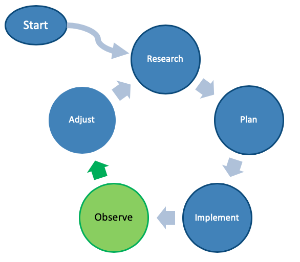Monitor the system for performance, operation, and results.
Go back to your plan; what were your goals? You knew you were starting on one side of a gulf, you defined both where you were at the start and where you wanted to be in terms of your NMS. Now, it's time to collect and review metrics to ensure you are meeting your goal(s).
The first thing to realize is in the short term your team will be opening and resolving more tickets. This is normal. Opmantek's NMS provides more detailed information about the health of your equipment and the services/applications they support. As your team analyses this information and implements improvements to the performance and reliability of the network the number of common/routine events will naturally reduce. Generally, this will take up to four months from the completion of implementation and switch-over.
The Observation step generally takes 90-120 days in order to allow users to absorb the training, adopt new processes, and begin leveraging the information to improve the performance and reliability of the network. Once this data is captured it can be analyzed in order to determine if the original goals outlined in Research have been met, which if any need to be adjusted, and what new goals might be achieved in the next round of improvements.
Hard Impact; these include observable, measurable metrics
- Number of tickets opened (by shift, by day of the week, by device type/problem/priority)
- Mean Time to Resolution (MTTR)
- Mean Time Between Failures (MTBF); this metric CANNOT be affected by any NMS, as it is defined by the models of devices deployed
- How many Support tickets are you opening with Opmantek?
So, while the number of tickets is an important metric to monitor, the key attribute is the time from ticket open to resolution, or MTTR. Tracking the meantime to resolution will give you the ability to gauge how long the impact is on operations. Aligning this with ticket priority, as a relative measurement of end-customer impact, will provide a three-dimensional reflection of performance improvement.
It is important to note, MTTR is just one metric of several that should be monitored before and after NMS conversion.
Soft Impact
- Change Management; Are departments and individual operators taking ownership of the NMS solution?
- Training Quality; Are users familiar with the solution interface, documentation, and your architecture. Do they know where to go when they have questions?
- User Moral; how are users adapting to the new system; is there a shadow IT solution still in use?
- User Investment;
- Management Support; Is management "on-board" with the new system, is the new NMS supported from the top-down; is user adoption expected and supported
Next Up
Adjust - use your observations as inputs to adjust your Plan
